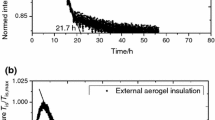Abstract
In buildings, windows have a major influence on space heating demand and indoor environment both with respect to climate and daylight. To reduce the window coefficient of the overall heat transmission, we use aerogel. Aerogels have a high surface area, low density, open pore structure, and excellent insulation properties. We mixed pressure sensitive adhesive and aerogel (10, 15, and 20 mass%) using a homogenizer. A mixture of the adhesives and silica aerogels attached film can reduce thermal conductivity. Silica aerogels are characterized by a surface area analyzer (BET), a Fourier transform infrared spectrometer, a thermogravimetry (TG) analyzer, and probe tack method. Thermal conductivity was measured by a TCi thermal conductivity analyzer.






Similar content being viewed by others
References
Baetens R, Jelle BP, Gustavsen A. Aerogel insulation for building applications: a state-of-the-art review. Energy Build. 2011;43:761–9.
Cha J, Seo J, Kim S. Building materials thermal conductivity measurement and correlation with heat flow meter, laser flash analysis and TCi. J Therm Anal Calorim. 2012;109:295–300.
Schultz JM, Jensen KI. Evacuated aerogel glazings. Vacuum. 2008;82:723–9.
Smith DM, Maskara A, Boes U. Aerogel-based thermal insulation. J Non Cryst Solids. 1998;225:254–9.
Zeng SQ, Hunt AJ, Cao W, Greif R. Pore size distribution and apparent thermal conductivity of silica aerogel. J Heat Transf. 1994;116:756–9.
Bommel MJ, Engelsen CW, Miltenburg JC. A thermoporometry study of fumed silica/aerogel composites. J Porous Mater. 1997;4:143–50.
Gesser HD, Goswami PC. Aerogels and related porous materials. Chem Rev. 1989;89:765–88.
Silveira NP, Ehrburger-Delle F, Rochas C, Rigacci A, Bargas-Pereira F, Westfahl H. Smectic ordering in polymer liquid crystal-silica aerogel nanocomposites. J Therm Anal Calorim. 2005;79:579–85.
Jesenak K, Kuchta L, Hudec P, Fajnor VS. Calcination of SiO2-aerogel in oxidizing atmosphere. J Therm Anal Calorim. 1999;55:773–7.
Richter K, Norris PM, Chang CL. Aerogels: applications, structure and heat transfer phenomena. Annu Rev Heat Transf. 1995;6:61–114.
Zhao J, Duan Y, Wang X, Wang B. Radiative properties and heat transfer characteristics of fiber-loaded silica aerogel composites for thermal insulation. Int J Heat Mass Transf. 2012;55:5196–204.
Zhao J, et al. Optical and radiative properties of infrared opacifier particles loaded in silica aerogels for high temperature thermal insulation. Int J Therm Sci. 2013;70:54–64.
Kim S, Seo J, Cha J, Kim S. Chemical retreating for gel-typed aerogel and insulation performance of cement containing aerogel. Constr Build Mater. 2013;40:501–5.
Schmidt M, Schwertfeger F. Applications for silica aerogel products. J Non Cryst Solids. 1998;225:364–8.
Wei G, Liu Y, Zhang X, Yu F, Du X. Thermal conductivities study on silica aerogel and its composite insulation materials. Int J Heat Mass Transf. 2011;54:2355–66.
Lu X, Ardunini-Schuster MC, Kuhn J, Nilsson O, Fricke J, Pekala RW. Thermal conductivity of monolithic organic aerogels. Science. 1992;255:971–2.
Kim S, Drzal LT. High latent heat storage and high thermal conductive phase change materials using exfoliated graphite nanoplatelets. Sol Energy Mater Sol Cells. 2009;93:136–42.
Kim H, Lee B, Choi S, Kim S, Kim H. The effect of types of maleic anhydride-grafted polypropylene (MAPP) on the interfacial adhesion properties of bio-flour-filled polypropylene composites. Compos A. 2007;38:1473–82.
Kuvandykova D. A new transient method to measure thermal conductivity of asphalt. C-Therm Technol. 2010;2:1–10.
Kuvandykova D, St-Laurent R. Application of the modified transient plane source technique in testing the thermal conductivity of concrete. C-Therm Technol. 2010;18:1–7.
Joo HS, Do HS, Park YJ, Kim HJ. Adhesion performance of UV-cured semi-IPN structure acrylic pressure sensitive adhesives. J Adhes Sci Technol. 2006;20:1573–94.
Kim B, Kim S, Do H, Kim S, Kim H. Probe tack of tackified acrylic emulsion PSAs. Int J Adhes Adhes. 2007;27:102–7.
Acknowledgements
This study was supported by the Soongsil University Research Fund of 2012.
Author information
Authors and Affiliations
Corresponding author
Rights and permissions
About this article
Cite this article
Cha, J., Kim, S., Park, KW. et al. Improvement of window thermal performance using aerogel insulation film for building energy saving. J Therm Anal Calorim 116, 219–224 (2014). https://doi.org/10.1007/s10973-013-3521-5
Received:
Accepted:
Published:
Issue Date:
DOI: https://doi.org/10.1007/s10973-013-3521-5




